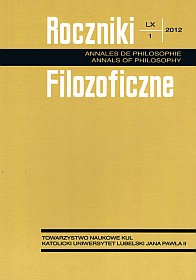Wittgenstein on the Role of Religious Pictures
Abstract
According to the later Wittgenstein, religious beliefs are ethically and existentially meaningful, being an important guidance in the life of a believer, and expressing a rule “clothed” in a picture. In the article I try to determine the role of some religious pictures mentioned by the author of “Lectures on Religious Belief”, e.g. the picture of God and the Last Judgment. A key issue of this conception is a denial that religious pictures depict or denote metaphysical reality. The view that a language of religion is non-referential means its deontologisation and is the core of non-cognitivism, within the scope of which Wittgenstein offers a functional approach: the philosopher’s task is to describe – by means of grammatical investigations – the use of religious pictures in the practice of a believer. Does Wittgenstein subscribe to radical reductionism, reject metaphysics and reduce religion to ethics? I point out that his analysis of the grammar of the word “God” can be interpreted in the spirit of negative theology. Religious concepts are dissimilar to the ordinary language concepts; the meaning of religious beliefs regarded as cognitive assertions is not clearly defined, they have, so to speak, no (clear) meaning. Hence, one may venture to say that the later Wittgenstein leaves to metaphysics a blank area for “the Inexpressible”. If so, it brings to mind a famous sentence from the Tractatus Logico-Philosophicus: “Whereof one cannot speak, thereof one must be silent”.
References
Ambrose A. (red.): Wittgenstein’s Lectures: Cambridge, 1932-1935, Blackwell 1979.
Arrington R.L., Addis M. (red.): Wittgenstein and Philosophy of Religion, London–New York: Routledge 2004.
Bremer J.: Ludwig Wittgenstein a religia, Kraków: Wyższa Szkoła Filozoficzno-Pedagogiczna Ignatianum, Wydawnictwo WAM 2002.
Churchill L.: „Rat’s and mole’s epiphany of Pan: Wittgenstein on Seeing Aspects and Religious Belief”, [w:] Philosophical Investigations 21:2, April 1998.
Chwedeńczuk B. (red.): Filozofia religii. Fragmenty filozofii analitycznej, Warszawa: Wydawnictwo Spacja 1997.
Creegan C.: Wittgenstein and Kierkegaard. Religion, Individuality and the Philosophical Method, London–New York: Routledge 1989.
Davies B.: Wprowadzenie do filozofii religii, tłum. W. Popowski, Warszawa: Prószyński i S-ka 2006.
Insole Ch.: A Wittgensteinian Philosophy of Religion – or a Philosophy of Wittgenstainian Religion?, „The Heythrop Journal” 39 (1998).
Kellenberger J.: Wittgenstein’s gift to contemporary analytic philosophy of religion, „International Journal for Philosophy of Religion” 28 (1990), No. 3.
Lichtenberg G. Ch.: Bruliony i inne pisma, tł. T. Zatorski, Kraków: Aureus 2001.
Monk R.: Ludwig Wittgenstein. Powinność geniusza, tł. A. Lipszyc, Ł. Sommer, Warszawa: Wydawnictwo KR 2003.
Schönbaumsfeld G.: A Confusion of the Spheres. Kierkegaard and Wittgenstein on Philosophy and Religion, Oxford: Oxford University Press 2007.
Wainwright W.J. (red.): The Oxford Handbook of Philosophy of Religion, Oxford: Oxford University Press 2005.
Wittgenstein L.: Uwagi o religii i etyce, tł. M. Kawecka, W. Sady, W. Walentukiewicz, Kraków: Wydawnictwo Znak 1995.
Wittgenstein L.: Niebieski i brązowy zeszyt. Szkice do Dociekań filozoficznych, tł. A. Lipszyc, Ł. Sommer, Warszawa: Wydawnictwo Spacja 1998.
Wittgenstein L.: Kartki, tł. S. Lisiecka, Warszawa: Wydawnictwo KR 1999.
Wittgenstein L.: Uwagi różne, tł. M. Kowalewska, Warszawa: Wydawnictwo KR 2000.
Wittgenstein L.: O pewności, tł. B. Chwedeńczuk, Warszawa: Wydawnictwo KR 2001.
Wittgenstein L.: Dociekania filozoficzne, tł. B. Wolniewicz, Warszawa: PWN 2004.
Wszołek S.: Wprowadzenie do filozofii religii, Kraków: Wydawnictwo WAM 2004.
Ziemiński I.: Śmierć, nieśmiertelność, sens życia: egzystencjalny wymiar filozofii Ludwiga Wittgensteina, Kraków: Aureus 2006.
Copyright (c) 2012 Roczniki Filozoficzne

This work is licensed under a Creative Commons Attribution-NonCommercial-NoDerivatives 4.0 International License.





